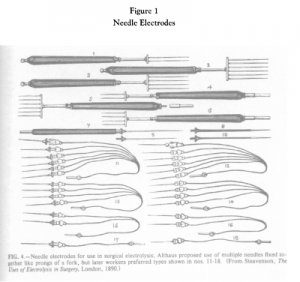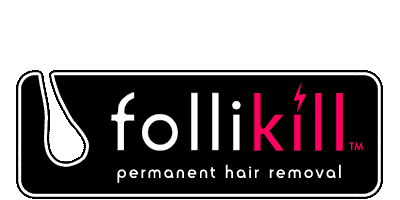The Invention Of Electrolysis
The term electrolysis was coined in 1834 by Englishman William Whewell to refer to “chemical decomposition by galvanic current”. It was the age of the polymath (generally middle and upper class men who were knowledgeable in many subject areas including physics, chemistry, geology, biology, languages, theology and more) and learned men of the period experimented with galvanic current to discover its uses and applications in various branches of science. Throughout the 1850s and 60s physicians began experimenting with electrical current to treat ailments from epilepsy to tumours but its application in the treatment of excess hair was still a decade away.
It wasn’t until 1875 that an American ophthamologist, G. E Michel, used electrolysis to treat a condition known as trichiasis – eyelashes that were ingrown or growing on the eyelid itself. There is some evidence the French may have been doing this a few decades earlier but Michel reported his results in a published essay where he also indicated the same technique could benefit “bearded women”. Until this point hair removal was a procedure that was self-administered at home. Pumice stones were used to scrape off the hair (and several layers of skin I imagine!), depilatories were made using caustic quicklime solutions and a crude form of waxing was done using shoemaker’s wax made up of beeswax and rosin. Can you believe that most of these ad hoc inventions were used on the face???
The Invention Of Electrolysis Hair Removal
Once the connection between electrical current and hair removal was made then there were a plentiful supply of both doctors willing to perform the service and patients who were desperate for some way to eradicate their unwanted hair. Miss X was the first recorded patient to receive a series of electrolysis treatments. According to the records of her physician, W.A Hardaway, Miss X possessed a beard of “patriarchal” proportions that would be the envy of men were it not possessed by this unfortunate girl. The beard was removed by Hardaway and a colleague over the course of 350 sessions of 1-2 hours each!

Electrolysis probes used in the early days of electrolysis in the 19th century. Some of the early probes resembled forks!
Miss X and all the women who received electrolysis in the early days need to be lauded for their bravery. The were not being treated with the sleek units of today, the doctors made their own units with huge batteries and lots of cords. The current was highly irregular and the procedures were very painful (there is mention made of energy levels up to 18 mA!). The probes were not the fine, flexible tips we use today, but rather sharp, rigid needles. Scarring might often have been the price paid for ridding oneself of unwanted hair.
It’s interesting to note the parallels between the industry of yesteryear and that of today. Electrolysis has never really been granted the respect it is due and that was true in the early days as well. Doctors were chided for doing low status work when they should be attending genuinely sick people who needed curing. Hair removal was considered little more than a vanity service. Fortunately for all of us (both clients and electrologists) these pioneers carried on and continued to treat women and men who felt hindered by their hairiness.
Source
Herzig, Rebecca. “Subjected To The Current: Batteries, Bodies and the Early History of Electrification of the United States”, Journal of Social History 41:4 (Summer 2008), 867-85.
Further Reading:
https://www.follikill.com/2014/01/24/shave-before-electrolysis-hair-removal-treatment/
Can Electrolysis Fail – What To Do If Electrolysis Treatment Fails?
